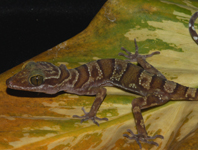Abstract
Variation is discussed concerning the number of antennal segments in adults, and the number of their sense cones, among 182 of the 289 genera of Thripidae. Brief comments are also made concerning antennal structure and sensoria among the other seven terebrantian families. The plesiotypic condition for Thysanoptera is 9-segmented antennae, but fusion between various segments leads to a reduction in number to as few as five segments, and such fusion occurs in unrelated species. In Thripidae, antennal segment III never bears more than one sense cone, but the distribution of sense cones on segments IV–VIII varies and is tabulated. On antennal segment IV, species in nearly all Panchaetothripinae genera and more than half of Thripinae genera have two sense cones, but genera of Dendrothripinae and Sericothripinae bear only one on this segment. The differing patterns of segmental fusion that occur in Thripidae are discussed in association with the number of sense cones on VI–VIII; species with 7, 8 or 9 segmented antennae almost always lack a sense cone on the terminal segment. It is concluded that the number of antennal segments is subject to irregular homoplasy, and is thus sometimes an unreliable indicator of relationships.
References
Buckman, R.S., Mound, L.A. & Whiting, M.F. (2013) Phylogeny of thrips (Insecta: Thysanoptera) based on five molecular loci. Systematic Entomology, 38, 123–133.
https://doi.org/10.1111/j.1365-3113.2012.00650.x
De Facci, M.D., Wallén, R., Hallberg, E. & Anderbrant, O. (2011) Flagellar sensilla of the eusocial gall-inducing thrips Kladothrips intermedius and its kleptoparasite, Koptothrips dyskritus (Thysanoptera: Phlaeothripinae). Arthropod Structure & Development, 40, 495–508.
https://doi.org/10.1016/j.asd.2011.05.004
Grimaldi, D., Shmakov, A. & Fraser, N. (2004) Mesozoic thrips and early evolution of the Order Thysanoptera (Insecta). Journal of Palaeontology, 78 (5), 941–952.
https://doi.org/10.1666/0022-3360(2004)078%3C0941:MTAEEO%3E2.0.CO;2
Hind, W.E. (1902) Contributions to a monograph of the insects of the order Thysanoptera inhabiting North America. Proceedings of the United States National Museum, 26, 79–242.
https://doi.org/10.5479/si.00963801.26-1310.79
Lima, E.F.B. & Mound L.A. (2016) Systematic relationships of the Thripidae subfamily Sericothripinae (Insect: Thysanoptera). Zoologischer Anzeiger, 263, 24–32.
https://doi.org/10.1016/j.jcz.2016.03.001
Marullo, R. (1998) Diversity of antennal sensoria amongst species in the basal clades of the Thysanoptera. Entomologist’s Monthly Magazine, 134, 345–349.
Masumoto, M. & Okajima, S. (2006) A revision of and key to the world species of Mycterothrips Trybom (Thysanoptera, Thripidae). Zootaxa, 1261, 1–90.
Masumoto, M. & Okajima, S. (2017) Anaphothrips genus-group: key to world genera, with two new species and three new records from Japan (Thysanoptera, Thripidae). Zootaxa, 4274 (2), 201–220.
https://doi.org/10.11646/zootaxa.4272.2.3
Masumoto, M. & Okajima, S. (2018) Rhamphothrips genus-group (Thysanoptera, Thripidae) in Japan, with three new species. Zootaxa, 4504 (2), 261–275.
https://doi.org/10.11646/zootaxa.4504.2.7
Mound, L.A. (2002) The Thrips and Frankliniella genus groups: the phylogenetic significance of ctenidia. In: Marullo, R. & Mound, L.A. (Eds.), Thrips and Tospoviruses: Proceedings of the 7th International Symposium on Thysanoptera. Australian National Insect Collection, Canberra, pp. 379–386. Available from: http://www.ento.csiro.au/thysanoptera/symposium.php (Accessed 7 Feb. 2019)
Mound, L.A. (2009) Sternal pore plates (glandular areas) of male Thripidae (Thysanoptera). Zootaxa, 2129, 29–46.
Mound, L.A., Heming, B.S. & Palmer, J.M. (1980) Phylogenetic relationships between the families of recent Thysanoptera. Zoological Journal of the Linnean Society, 69, 111–141.
https://doi.org/10.1111/j.1096-3642.1980.tb01934.x
Mound, L.A. & Marullo, R. (1996) The Thrips of Central and South America: An Introduction. Memoirs on Entomology, International, 6, 1–488.
Mound, L.A. & Morris, D.C. (2007) The insect order Thysanoptera: classification versus systematics. Zootaxa, 1668, 395–441.
Mound, L.A. & Palmer, J.M. (1981) Phylogenetic relationships between some genera of Thripidae (Thysanoptera). Entomologica Scandinavica, 15, 153–170.
Mound, L.A. & Reynaud, P. (2005) Franklinothrips; a pantropical Thysanoptera genus of ant-mimicking obligate predators (Aeolothripidae). Zootaxa, 864, 1–16.
https://doi.org/10.11646/zootaxa.864.1.1
Ng, F.Y. & Mound, L.A. (2015) Genera of the Scirtothrips genus-group (Thysanoptera, Thripidae) with a new species of Siamothrips from Malaysia. Zootaxa, 4021 (2), 387–394.
https://doi.org/10.11646/zootaxa.4021.2.9
Palmer, J.M. & Mound, L.A. (1978) Nine genera of fungus-feeding Phlaeothripidae (Thysanoptera) from the Oriental Region. Bulletin of the British Museum (Natural History) Entomology, 37, 153–215.
Palmer, J.M. & Mound, L.A. (1985) New world Thripidae (Thysanoptera) with nine-segmented antennae. Zoological Journal of the Linnean Society, 84, 181–194.
https://doi.org/10.1111/j.1096-3642.1985.tb01798.x
Schliephake, G. (1993) Beiträge zur Kenntnis fossiler Fransenflügler (Thysanoptera) aus dem Bernstein des Tertiär, 2. Beitrag: Aeolothripidae (Melanthripinae) und Thripidae (Dendrothripinae und Thripinae). Zoologisches Jahrbücher, Abteilung für Systematik, Ö kologie und Geographie der Tiere, 120, 215–251.
Slifer, E.H. & Sekhon, S.S. (1974) Sense organs on the antennae of two species of thrips (Thysanoptera, Insecta). Journal of Morphology, 143, 445–456.
https://doi.org/10.1002/jmor.1051430407
ThripsWiki (2018) ThripsWiki—providing information on the World’s thrips. https://thrips.info/wiki/Main%20Page (accessed 1 November 2018)
Tyagi, K., Kumar, V. & Mound, L.A. (2008) Sexual dimorphism among Thysanoptera Terebrantia, with a new species from Malaysia and remarkable species from India in Aeolothripidae and Thripidae. Insect Systematics and Evolution, 39, 155–170.
https://doi.org/10.1163/187631208788784093
Ulitzka, M.R. (2018) A first survey of Cretaceous thrips from Burmese amber including the establishment of a new family of Tubulifera (Insecta: Thysanoptera). Zootaxa, 4486 (4), 548–558.
https://doi.org/10.11646/zootaxa.4486.4.8
Wilson, T.H. (1975) A monograph of the subfamily Panchaetothripinae (Thysanoptera: Thripidae). Memoirs of the American Entomological Institute, 23, 1–354.

